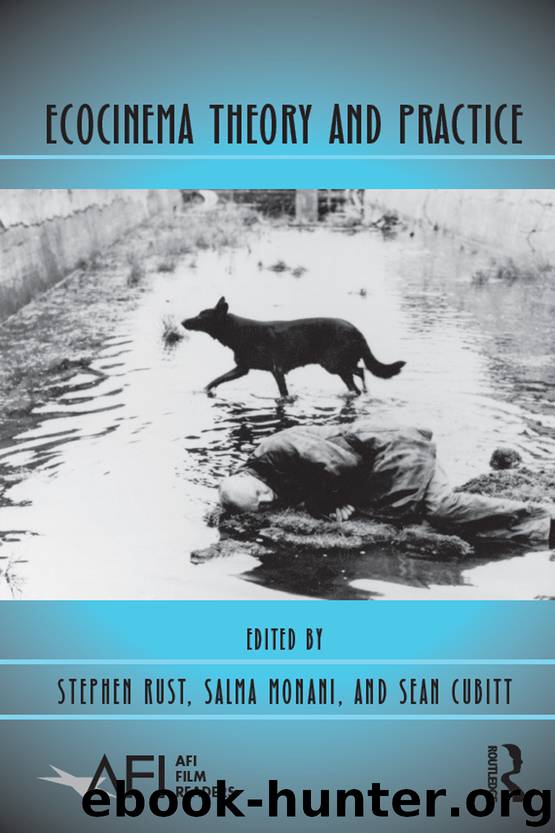Ecocinema Theory and Practice by Rust Stephen; Monani Salma; Cubitt Sean

Author:Rust, Stephen; Monani, Salma; Cubitt, Sean
Language: eng
Format: epub
Publisher: Taylor and Francis
conclusion: the end of the line
The early history of undersea filmmaking continues to hold weight today, as the tropes advanced during each of these periods has shaped subsequent views of the ocean. There was a move back to aquatic monsters in the 1970s in Blue Water White Death (1971) and Jaws (1975), and the ocean emerged once again as a site for extraterrestrial life in The Abyss (1989). Indeed, much aquatic ecocinema continues to assume, following the shift in the 1960s, that the only life that can be seen as “naturally” inhabiting the ocean are nonhuman forms of life.
However, there are some productive counterpoints to this model. One recent documentary on global overfishing, The End of the Line (2009), predicates its environmentalism not simply on advocating for the preservation of nonhuman Others but on seeing the ocean as an entity that exists in (and has to be governed in relation to) a divided and unequal political world. The film begins with a traditional set of images, opening with a series of close-ups of fish, coral, and micro-organisms. An attention to their vibrant colors and detailed textures offers a sense of an intimacy with nonhuman life. No shots or narration locate us in relation to the world above. Cutting to a swarm of sharks, the film leads us to believe that these are their predators. In a series of cuts between sharks and people in silhouette, the film quickly reveals a bloody slaughter of the sharks. A long shot reveals two black men on the ship, slitting the throat of a shark, blood dripping down. The opening opposes humans and the sea, and figures illegal fishing as a racialized invasion into the sharks’ territory.
As the plot unfolds, however, there is a turn to the stories of local fishermen, as well as a critique of broader social and systemic problems: multinational corporate investment, international policies, and consumer ignorance are all to blame. The film also criticizes the role of representation in depleting the oceans, suggesting that commercials and cooking shows have built an “insatiable appetite” for fish. The film does not suggest that we stop fishing, or leave the “natural” world alone, but instead portrays fishing itself as a natural activity. Not all fishermen are to blame, only “an infamous minority of people making millions and millions.”
In one compelling scene, The End of the Line juxtaposes the struggle of artisanal fishermen in Africa with larger commercial boats, and reveals the problems of changing careers in a world that is still politically divided. A commentator notes, “the Europeans like the fish, but they don't like the people. The fish they will take, but the people are sent back,” a critique of the economic policies that govern European-African relations. Towards the film's end, it returns to the imagery of fish and aquatic life, but by this time the ocean has been reframed as a social space, inevitably wrapped up in economic exchanges and international politics and, like the films of the 1950s, a territory in conflict.
Download
This site does not store any files on its server. We only index and link to content provided by other sites. Please contact the content providers to delete copyright contents if any and email us, we'll remove relevant links or contents immediately.
Shoot Sexy by Ryan Armbrust(17557)
Portrait Mastery in Black & White: Learn the Signature Style of a Legendary Photographer by Tim Kelly(16872)
Adobe Camera Raw For Digital Photographers Only by Rob Sheppard(16797)
Photographically Speaking: A Deeper Look at Creating Stronger Images (Eva Spring's Library) by David duChemin(16498)
Bombshells: Glamour Girls of a Lifetime by Sullivan Steve(13685)
Art Nude Photography Explained: How to Photograph and Understand Great Art Nude Images by Simon Walden(12852)
Perfect Rhythm by Jae(5072)
Pillow Thoughts by Courtney Peppernell(4011)
The Book of Joy by Dalai Lama(3698)
Good by S. Walden(3347)
The Pixar Touch by David A. Price(3210)
A Dictionary of Sociology by Unknown(2854)
Fantastic Beasts: The Crimes of Grindelwald by J. K. Rowling(2843)
Humans of New York by Brandon Stanton(2687)
Stacked Decks by The Rotenberg Collection(2687)
Read This If You Want to Take Great Photographs by Carroll Henry(2602)
On Photography by Susan Sontag(2482)
Photographic Guide to the Birds of Indonesia by Strange Morten;(2407)
Insomniac City by Bill Hayes(2396)
